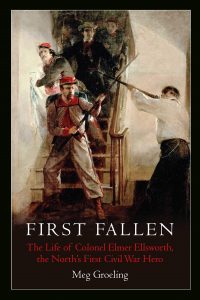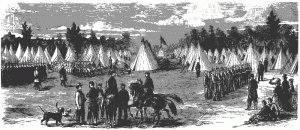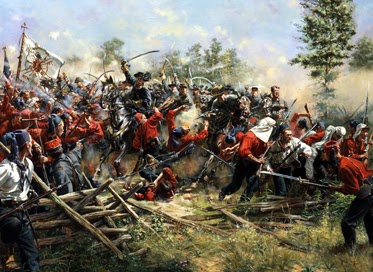The 11th New York Fire Zouaves: Seeing the Elephant, Part 1
 The following excerpt is taken from Groeling’s forthcoming book First Fallen: The Life of Colonel Elmer Ellsworth, the North’s First Civil War Hero. It will be released by Savas Beatie and can be preordered here: https://www.savasbeatie.com/contact-us/
The following excerpt is taken from Groeling’s forthcoming book First Fallen: The Life of Colonel Elmer Ellsworth, the North’s First Civil War Hero. It will be released by Savas Beatie and can be preordered here: https://www.savasbeatie.com/contact-us/
Colonel Elmer Ellsworth’s regiment was active during the last half of the battle, and have been the subject of much speculation concerning their performance. This series of posts should, I hope, clear up that concern.
 On July 14 there was finally some movement, which found the Fire Zouaves at a small, makeshift bivouac called Campbell’s Run, about three miles from Alexandria. There they were added to Major General Irvin McDowell’s larger forces, leaving their tents and belongings behind, to be brought up later by rail. At daylight on July 17, the Zouaves were ordered to march with the left part of the Third Division under the command of Major General Samuel Heintzelman, along Old Fairfax Road to Pohick Run.[1] Colonel Orlando B. Willcox’s command, the part of Heintzelman’s division under which the 11th New York served, continued from Pohick Run to Sangster’s Station, arriving about 5:00 PM.[2] This march was the first actual sustained military march the regiment had participated in, and it left many exhausted. According to correspondence from “J. A. S.” written to the Editors of the Sunday Mercury (New York City) on July 25:
On July 14 there was finally some movement, which found the Fire Zouaves at a small, makeshift bivouac called Campbell’s Run, about three miles from Alexandria. There they were added to Major General Irvin McDowell’s larger forces, leaving their tents and belongings behind, to be brought up later by rail. At daylight on July 17, the Zouaves were ordered to march with the left part of the Third Division under the command of Major General Samuel Heintzelman, along Old Fairfax Road to Pohick Run.[1] Colonel Orlando B. Willcox’s command, the part of Heintzelman’s division under which the 11th New York served, continued from Pohick Run to Sangster’s Station, arriving about 5:00 PM.[2] This march was the first actual sustained military march the regiment had participated in, and it left many exhausted. According to correspondence from “J. A. S.” written to the Editors of the Sunday Mercury (New York City) on July 25:
The men were given three days’ provisions in their haversacks, consisting solely of six pilot biscuits, a piece of salt pork, one small cup of ground coffee, and a cup of sugar. Then, leaving our encampment at about 10 o’clock in the morning, we took the road for Fairfax Station. . . . our brigade, consisting of the Michigan First, Scott Life Guard, and our own regiment, took a circuitous route through the woods to outflank the enemy at Fairfax Station. . . [3]
 When a small group of Fire Zouaves launched an attack on an entrenched group of Tennessee soldiers, private John Johnson, who had served with Lady Washington Engine Co. 40, got credit for capturing their colors. They moved on, to and beyond Fairfax, where they encountered the 39th New York Regiment, known as the Garibaldi Guards. The Garibaldis, clad in the distinctive Bersaglieri uniform of a dark blue and red tunic with broad-brimmed black hats, were mistaken for the enemy by the Fire Zouaves, who fired several shots at them before confirming their identity. The regiment, along with the other Union troops, then returned to Fairfax, and remained there until Saturday afternoon, July 20th.[4] They celebrated late the next morning by raising a United States flag, and left at 3:00 PM to march to Centerville:
When a small group of Fire Zouaves launched an attack on an entrenched group of Tennessee soldiers, private John Johnson, who had served with Lady Washington Engine Co. 40, got credit for capturing their colors. They moved on, to and beyond Fairfax, where they encountered the 39th New York Regiment, known as the Garibaldi Guards. The Garibaldis, clad in the distinctive Bersaglieri uniform of a dark blue and red tunic with broad-brimmed black hats, were mistaken for the enemy by the Fire Zouaves, who fired several shots at them before confirming their identity. The regiment, along with the other Union troops, then returned to Fairfax, and remained there until Saturday afternoon, July 20th.[4] They celebrated late the next morning by raising a United States flag, and left at 3:00 PM to march to Centerville:
Orders were immediately given to proceed as rapidly as possible, and at the same time we heard the most extravagant rumors that the New York Second and Twelfth Volunteers and the Sixty-ninth, had engaged some batteries near Bull’s Run, and were badly cut up, so as to need our immediate assistance. The men made the most super-human exertions until we arrived in Centerville, when we were told that our services were not required.[5]
Lieutenant Edwin B. Knox was a former member of the Chicago Zouave Cadets. When Elmer Ellsworth came to New York City to recruit the firefighters, he asked Knox to join him and gave him the rank of Lieutenant. His statement concerning the continuing actions of the 11th New York Zouaves begins:
The regiment was encamped about a mile this side of Centerville. At 2 o’clock AM on Sunday morning (July 21) the men were aroused and remained under arms until 7 o’clock AM, at which time they started forward. There were 950 men, all told, with “Pony” Farnham at their head. With cheers they moved briskly forward through the woods, singing and laughing and eager for the fight. They had marched about fourteen miles and were within three miles of the battlefield, when they heard the guns and saw the smoke from an eminence. This excited the men wonderfully, and at a double-quick step they pressed on, with the intention of joining Col. Wilcox, who, with the Michigan regiment, was a short way ahead. Halting at a pool of dirty water, they refreshed themselves, and went on until they came to a church three quarters of a mile this side of the battlefield, where they left their overcoats and haversacks, and having formed by companies, again went on at double-quick step.[6]
After moving at the double-quick for a distance of about fourteen miles, the regiment came to a halt. Lt. Col. Creiger ordered everyone who had not previously done so to take off their coats, drop blanket rolls, haversacks, and canteens. Private Metcalf continued:[8]
Cheer after cheer rang out for our regiment at the prospect of at last finding the foe, and yet many among us were suffering from the intense heat and want of water, for nearly all the canteens were empty by this time.[9]
Finally, Ellsworth’s Fire Zouaves were on the field of battle, but not everyone was glad to see the red-shirted volunteers. It was almost 1:30 PM on Sunday, July 21, and at this point, McDowell seemed to have the battle going his way. Matthews Hill had been under Federal control since noon, but McDowell realized that it would take more than an artillery duel to clear the field at the Henry House. He would need to move Federal artillery closer, and back it with infantry. He ordered his Chief of Artillery, Major William Barry, to direct Captain Charles Griffin and Captain James B. Ricketts to move their eleven guns across Young’s Branch Valley and up to the Henry Hill field. Both men immediately protested, unsure of adequate infantry support. Captain Griffin suggested to Major Barry that the infantry go ahead, get into position on the hill, and then have the guns come up behind them. At that point, the infantry could fall back. Barry assured both captains that orders had already been given for the 11th New York to follow them to the field. Griffin, an Army regular, had little confidence in the ability of the flashy, volunteer Zouaves to perform under fire. Barry, who had no intention of changing his commander’s orders, replied, “Yes, they will. At any rate, it is General McDowell’s order to go there.”[10]
Griffin was not impressed. “I will go, but mark my words, they will not support us.”[11] Despite questions, McDowell’s orders stood. Griffin’s three 10-pounder Parrott guns and two 12-pound howitzers were moved south along Sudley Road, while Ricketts turned his guns off the road and on to the field at Henry Hill.
Behind us in the valley, the 14th Brooklyn were drawn up in line and were resting. Oh, if we could but get some rest, just five minutes, to catch one good long breath,–one moment to get a sip of water . . . No, not for us. Up rode an officer sword in hand ere we had hardly halted. “Colonel,” he shouted. “the General [Heintzelman] has decided to put you right into it. Let the colors advance ten paces. Detail two of your companies as a reserve. Dress on your colors.” ‘Twas done. “Come on boys and show them what New York can do!” And with that the pet lambs were led to the slaughter.[12]
 ___________________________________________________________
___________________________________________________________
[1]The Civil War Archives: Union Regimental Histories: New York, “11th Regiment Infantry “1st New York Fire Zouaves” “Ellsworth’s Zouaves,” [online version available through http://www.civilwararchive.com/Unreghst/unnyinf1.htm (accessed January 21, 2018)].
[2]Bradley M. Gottfried, The Maps of First Bull Run: An Atlas of the First Bull Run (Manassas) Campaign, including the Battle of Ball’s Bluff, June-October 1861, (New York and California: Savas Beatie, 2009), 10-11.
[3]William B. Styple, ed., Writing and Fighting the Civil War: Soldier Correspondence to the New York Sunday Mercury. “J. A. S. to the Editors of the Sunday Mercury, July 25, 1861,” (http://www.amazon.com/Writing-Fighting-Civil-War-Correspondence/dp.18839261300, 32-34.
[4]Brian Pohanka, Marc A. Hermann, Shaun C. Grenan, “Tiger! Zouave!” http://www.myrtle-avenue.com/firezou/ (accessed June 2013).
[5]Ibid.
[6]Lieutenant Edwin B. Knox, “Ellsworth’s Zouaves at Bull Run, “Wisconsin Weekly Patriot (August 3, 1861). [online version available through https//bullrunnings.wordpress.com/2011/07/20/letter-from-the-fire-zouaves/ (accessed August 23, 2016)].
[7]Lieutenant Edwin B. Knox, “Ellsworth’s Zouaves at Bull Run, “Wisconsin Weekly Patriot (August 3, 1861). [online version available through https//bullrunnings.wordpress.com/2011/07/20/letter-from-the-fire-zouaves/ (accessed August 23, 2016)].
[8]Pohanka, Hermann, Grenan, “Tiger! Zouave!” (accessed June 2013).
[9]Metcalfe, “So Eager Were We All.”
[10]37th Congress, 3rd Session, House of Representatives, Report of the Joint Committee on the Conduct of the War: Bull Run, Ball’s Bluff, (Washington: U. S. Government Printing Office, 1863), 168-169.
[11]Ibid.
[12]Ibid.
Great stuff is well worth the wait…
Hear, Hear!
Thanks so much. I hope you enjoy the book.
Another fine post! If it hadn’t been for Ellsworth’s flashiness and connection to Lincoln, as well as the melodramatic circumstances of his departure, one doubts that the Fire Zouaves would merit more than an asterix in history. I personally would like to know more about James Jackson, the John Burns of Alexandria. But whereas the wounded Burns lied his way out of a hanging and actually had his wounds tended by the enemy, Jackson, effectively unarmed after the discharge of his shotgun is in turn shot and bayoneted.. His heroic assailant is then awarded the Medal of Honor! Burns gets a statute on McPherson’s Ridge; Jackson got a plaque removed by a quivering corporation. So much for the modern litany that the losers of the Civil War always control the narrative.
So true… Corporal Brownell should have utilized his Pepper-spray, or perhaps his taser, and verified that Jackson was not armed with an Arkansas Toothpick. Then, Jackson should have been politely asked if he wished to surrender…
ROFLMAO!
That would be fully in accord with modern police procedure, where before Brownell bayoneted him he would have required Jackson to sign a waiver of liability form accepting permissible force. I still want a statue for Jackson. I think Brownell’s MOH is one of the most laughable of the war. And Ellsworth was an hilarious hot dog, a Fremont Wannabee!?And I LMAO as well!
I may disagree with you about Ellsworth being a hot dog, but there is an appendix on Jackson in the book, and I have tried very hard to show that he was a spirited southerner who defended his hotel against someone he saw as an intruder. Fairness to Jackson, I say!
Enjoyable reading.